Karstification and Its Role in the Formation of Carbonate Reservoirs: A Case Study from the Ordovician Majiagou Formation in Jingbian, Ordos Basin, North China
Abstract
:1. Introduction
2. Geological Setting
3. Methodolgy
3.1. Core Analysis
3.2. Laboratory Analysis
4. Results
4.1. Pore Types
4.2. Syngenetic Karstification
4.2.1. Selective Dissolution
4.2.2. Solution Fracture, Lithology Mutation, and Brecciation
4.3. Weathering Crust Karst
4.3.1. Erosion Unconformity
4.3.2. Karst Characteristics of Weathered Crust
4.4. Buried Karstification
5. Discussion
5.1. Syngenetic Karst and Its Control on Formation of Pores
5.2. Weathering Crust Karst and Its Control on the Formation of Pores
5.3. Buried Karst and Its Control on the Formation of Pores
6. Conclusions
- (1)
- The pore types in the fifth member of the Majiagou Formation in the Jingbian area of the Ordos Basin include interparticle pores, separate-vuggy pores, and touching-vuggy pores. Interparticle pores consist of both intercrystal and intergrain. Separate-vuggy pores consist of moldic and intraparticle pores. Touching-vuggy pores consist of cavernous pores and fractures.
- (2)
- The dolomite reservoir in the fifth member of the Majiagou Formation in the Jingbian area of the Ordos Basin has experienced three stages of karstification: syngenetic karst, weathered crust karst, and buried karst. These stages were influenced by fluctuations in sea level, periods of exposure, and the release of organic acids during hydrocarbon generation.
- (3)
- Syngenetic karst and medium, shallowly buried karst are the critical stages for the formation and preservation of reservoir space. Mold pores and intragranular dissolution pores formed in syngenetic karst by selective dissolution are especially important in the formation of carbonate gas reservoirs. Pores and fractures formed in the weathering crust provide some reservoir space in carbonate. Buried karstification in the study area produced sutures, calcite, and dolomite precipitated in moldic pores, and also structural fractures, solution expansion structural fractures, and intergranular solution pores.
- (4)
- The Majiagou Formation exhibits well-developed structural and diagenetic fractures, which play a crucial role in facilitating the migration of natural gas reservoirs.
Author Contributions
Funding
Data Availability Statement
Acknowledgments
Conflicts of Interest
References
- Araújo, R.E.; La Bruna, V.; Rustichelli, A.; Bezerra, F.H.; Xavier, M.M.; Audra, P.; Barbosa, J.A.; Antonino, A.C. Structural and Sedimentary Discontinuities Control the Generation of Karst Dissolution Cavities in a Carbonate Sequence, Potiguar Basin, Brazil. Mar. Pet. Geol. 2021, 123, 104753. [Google Scholar] [CrossRef]
- Bagni, F.L.; Erthal, M.M.; Tonietto, S.N.; Maia, R.P.; Bezerra, F.H.; Balsamo, F.; Córdoba, V.C.; de Souza, F.G.; Brod, J.A.; Fernandes, C.P.; et al. Karstified Layers and Caves Formed by Superposed Epigenic Dissolution along Subaerial Unconformities in Carbonate Rocks—Impact on Reservoir-Scale Permeability. Mar. Pet. Geol. 2022, 138, 105523. [Google Scholar] [CrossRef]
- Furtado, C.P.Q.; Medeiros, W.E.; Borges, S.V. The Influence of Subseismic-Scale Fracture Interconnectivity on Fluid Flow in Fracture Corridors of the Brejoes Carbonate Karst System, Brazil. Mar. Pet. Geol. 2022, 141, 105689. [Google Scholar] [CrossRef]
- Lima, R.S.; Nobre-Lopes, J.; Bezerra, F.H.R.; Maia, R.P.; Moura, P.E.F.; Lima-Filho, F.P.; Araújo, R.E.B.; La Bruna, V. Siliciclastic Content Controls the Sealing Behavior of Layers and Karst Development in a Carbonate-Siliciclastic Sequence, Salitre Formation, Brazil. Mar. Pet. Geol. 2023, 148, 106013. [Google Scholar] [CrossRef]
- Zhou, Y.; Yang, F.L.; Ji, Y.L.; Zhou, X.F.; Zhang, C.H. Characteristics and Controlling Factors of Dolomite Karst Reservoirs of the Sinian Dengying Formation, Central Sichuan Basin, Southwestern China. Precambrian Res. 2020, 343, 105708. [Google Scholar] [CrossRef]
- He, J.; Fang, S.X.; Hou, F.H.; Yan, R.H.; Zhao, Z.J.; Yao, J.; Tang, X.; Wu, G. Vertical Zonation of Weathered Crust Ancient Karst and Reservoir Evaluation and Prediction—A Case Study of M55–M51 Sub-Members of Majiagou Formation in Gas Fields, Central Ordos Basin, NW China. Pet. Explor. Dev. 2013, 40, 572–581. [Google Scholar] [CrossRef]
- Zhou, J.G.; Yu, Z.; Wu, D.X.; Ren, R.; Zhang, D.F.; Wang, S.Y.; Yin, C.; Liu, Y.X. Restoration of Formation Processes of Dolomite Reservoirs Based on Laser U-Pb Dating: A Case Study of Ordovician Majiagou Formation, Ordos Basin, NW China. Pet. Explor. Dev. 2022, 49, 327–338. [Google Scholar] [CrossRef]
- Liu, M.J.; Xiong, Y.; Xiong, C.; Liu, Y.; Liu, L.; Xiao, D.; Tan, X.C. Evolution of Diagenetic System and Its Controls on the Reservoir Quality of Pre-Salt Dolostone: The Case of the Lower Ordovician Majiagou Formation in the Central Ordos Basin, China. Mar. Pet. Geol. 2020, 122, 104674. [Google Scholar] [CrossRef]
- Xie, K.; Tan, X.; Feng, M.; Wang, B.; Zhong, S.; Yang, M.; Nie, W.; Qiao, Z.; Zeng, W. Eogenetic Karst and Its Control on Reservoirs in the Ordovician Majiagou Formation, Eastern Sulige Gas Field, Ordos Basin, NW China. Pet. Explor. Dev. 2020, 47, 1246–1261. [Google Scholar] [CrossRef]
- Fan, H.; Shi, J.Y.; Fan, T.L.; Gao, Z.Q.; Li, B. Sedimentary Microfacies Analysis of Carbonate Formation Based on FMI and Conventional Logs: A Case Study from the Ordovician in the Tahe Oilfield, Tarim Basin, China. J. Pet. Sci. Eng. 2021, 203, 108603. [Google Scholar] [CrossRef]
- Lucia, F.J. Carbonate Reservoir Characterization: An Integrated Approach. In Carbonate Reservoir Characterization An Integrated Approach, 2nd ed.; Springer: Berlin/Heidelberg, Germany, 2007. [Google Scholar]
- Méndez, J.N.; Jin, Q.; González, M.; Zhang, X.D.; Lobo, C.; Boateng, C.D.; Zambrano, M. Fracture Characterization and Modeling of Karsted Carbonate Reservoirs: A Case Study in Tahe Oilfield, Tarim Basin (Western China). Mar. Pet. Geol. 2020, 112, 104104. [Google Scholar] [CrossRef]
- Niu, Y.B.; Cheng, M.Y.; Zhang, L.J.; Zhong, J.H.; Liu, S.-X.; Wei, D.; Xu, Z.L.; Wang, P.J. Bioturbation Enhanced Petrophysical Properties in the Ordovician Carbonate Reservoir of the Tahe Oilfield, Tarim Basin, NW China. J. Palaeogeogr. 2022, 11, 31–51. [Google Scholar] [CrossRef]
- Liu, C.; Xie, Q.B.; Wang, G.W.; He, W.G.; Song, Y.F.; Tang, Y.; Wang, Y.H. Rare Earth Element Characteristics of the Carboniferous Huanglong Formation Dolomites in Eastern Sichuan Basin, Southwest China: Implications for Origins of Dolomitizing and Diagenetic Fluids. Mar. Pet. Geol. 2017, 81, 33–49. [Google Scholar] [CrossRef]
- Mgimba, M.M.; Jiang, S.; Mwakipunda, G.C. The Identification of Normal to Underpressured Formations in the Southeastern Sichuan Basin. J. Pet. Sci. Eng. 2022, 219, 111085. [Google Scholar] [CrossRef]
- Zhang, B.; Zheng, R.C.; Wang, X.B.; Luo, Y.; Li, W.; Wen, H.G.; Hu, Z.G. Paleokarst Features and Reservoir Distribution in the Huanglong Formation of Eastern Sichuan. Pet. Explor. Dev. 2011, 38, 257–267. [Google Scholar]
- Fang, S.X.; Hou, F.H.; Yang, X.Y.; Qiao, Y.; Lin, Q.; Fu, S.T.; Yao, J.L.; Wu, Z.; Yang, R.H.; Xu, L.M. Reservoirs Pore Space Types and Evolution in M55 to M51 Submembers of Majiagou Formation of Middle Ordovician in Central Gasfield Area of Ordos Basin. Acta Petrol. Sin. 2009, 25, 2425–2441. [Google Scholar]
- Fairey, B.J.; Timmerman, M.J.; Sudo, M.; Tsikos, H. The Role of Hydrothermal Activity in the Formation of Karst-Hosted Manganese Deposits of the Postmasburg Mn Field, Northern Cape Province, South Africa. Minerals 2019, 9, 408. [Google Scholar] [CrossRef]
- Carvalho, A.M.A.; Hamon, Y.; Jr, O.G.D.S. Facies and Diagenesis Distribution in an Aptian Pre-Salt Carbonate Reservoir of the Santos Basin, Offshore Brazil: A Comprehensive Quantitative Approach. Mar. Pet. Geol. 2022, 141, 105708. [Google Scholar] [CrossRef]
- Wang, P.; Wang, G.W.; Chen, Y.Q.; Hao, F.; Yang, X.; Hu, F.J.; Zhou, L.; Yi, Y.; Yang, G.; Wang, X.X.; et al. Formation and Preservation of Ultra-Deep High-Quality Dolomite Reservoirs under the Coupling of Sedimentation and Diagenesis in the Central Tarim Basin, NW China. Mar. Pet. Geol. 2023, 149, 106084. [Google Scholar] [CrossRef]
- Wang, X.T.; Wang, J.; Cao, Y.C.; Han, J.; Wu, K.Y.; Liu, Y.; Liu, K.Y.; Xie, M.F. Characteristics, Formation Mechanism and Evolution Model of Ordovician Carbonate Fault-Controlled Reservoirs in the Shunnan Area of the Shuntuogole Lower Uplift, Tarim Basin, China. Mar. Pet. Geol. 2022, 145, 105878. [Google Scholar] [CrossRef]
- Wei, W.; Azmy, K.; Zhu, X.M. Impact of Diagenesis on Reservoir Quality of the Lacustrine Mixed Carbonate-Siliciclastic-Volcaniclastic Rocks in China. J. Asian Earth Sci. 2022, 233, 105265. [Google Scholar] [CrossRef]
- Wang, Z.; Li, Z.; Niu, Z.; Li, C.; Chen, H.; Lin, X.; Hu, K.; Yao, H. Properties of Conglomerates from the Middle Ordovician Dongchong Formation and Its Response to the Yunan Orogeny in the Yunkai Area, South China. Minerals 2023, 13, 998. [Google Scholar] [CrossRef]
- Chen, J.; Li, Z.; Wang, Z. Paleokarstification and Reservoir Distribution of Ordovician Carbonates in Tarim Basin. Acta Sedimentol. Sin. 2007, 25, 858–868. [Google Scholar]
- Li, M.; Tang, L.J.; Yan, X.B.; Yun, L. Geometry, Formation Mechanisms, and Hydrocarbon Exploration Significance of Pishan Caldera, Tarim Basin, Northwest China. Pet. Sci. Technol. 2023, 41, 597–613. [Google Scholar] [CrossRef]
- Ren, C.Q.; Gao, X.Z.; Jiang, H.S.; Li, J.M.; He, F.G. Characteristics and Favorable Area Prediction of Ordovician Buried-Hill Carbonate Reservoirs in the Bozhong 21–2 Tectonic Belt, Bohai Bay Basin, China. Pet. Sci. Technol. 2018, 36, 1374–1381. [Google Scholar] [CrossRef]
- Zhou, Y.; Ding, Z.C.; Wang, L.H.; Zhang, B.F.; Luo, L.; Wei, Y.; Guo, W.; Wei, L.B. Main Factors Controlling Formation of Dolomite Reservoir Underlying Gypsum-Salt Layer in the 5~(Th) Member of Ordovician Majiagou Formation, Ordos Basin. Oil Gas Geol. 2018, 39, 1213–1223. [Google Scholar]
- Xiong, R.; Wang, Z.Y.; Zhang, Y.F. Burial Dissolution Formation Mechanism and Main Controlling Factors of Tazhong Ordovician. J. Chongqing Univ. Sci. Technol. Sci. Ed. 2016, 15, 14–17. (In Chinese) [Google Scholar]
- Zhang, Y.D.; Zhou, W.; Deng, K.; Wang, C.L.; Wang, Y.; Meng, X.L. Palaeogeomorphology and Reservoir Distribution of the Ordovician Karstified Carbonate Rocks in the Structurally-Gentle Gaoqiao Area, Ordos Basin. Acta Petrol. Sin. 2014, 30, 757–767. [Google Scholar]
- Wu, Y.S.; He, S.L.; Lu, T.; Da, S.P.; Li, Y.G.; Dai, Y.D. Diagenetic Patterns and Pore Systems of the Lower Ordovician Majiagou Formation Reservoirs of the Central Changqing Gas Fields. Acta Petrol. Sin. 2006, 22, 2171–2181. [Google Scholar]
- Bai, H.F.; Ma, Z.R.; Liu, B.X. Reservoir-Forming Potential of Majiagou Formation Ma-6 Section in Lower Ordovician in Southern Margin of Ordos Basin. Northwest. Geol. 2010, 43, 107–114. (In Chinese) [Google Scholar]
- Lei, B.J. Research on the Sedimentary Microfacies and Diageneses of Ma5_(1-4) Submember in Jingbian Gas Field. Acta Sedimentol. Sin. 2010, 28, 1153–1164. [Google Scholar]
- Fu, J.H.; Wu, X.N.; Sun, L.Y.; Yu, Z.; Huang, Z.L.; Ding, Z.C. New Understandings of the Lithofacies Paleogeography of the Middle Assemblage of Majiagou Fm in the Ordos Basin and Its Exploration Significance. Nat. Gas Ind. B 2017, 4, 278–286. [Google Scholar] [CrossRef]
- Zhang, T.J.; Wang, Y. The Relationship between Karst Palaeogeomorphology Recovery and Gas Enrichment in Ordos Basin:Example from Mawu Section of Ordovician Majiagou Formation in Gaoqiao Area. Northwest. Geol. 2017, 50, 207–213. [Google Scholar]
- Jiu, B.; Huang, W.H.; Mu, N.N.; Li, Y. Types and Controlling Factors of Ordovician Paleokarst Carbonate Reservoirs in the Southeastern Ordos Basin, China. J. Pet. Sci. Eng. 2021, 198, 108162. [Google Scholar] [CrossRef]
- Xu, X.; Feng, Q.H.; Wei, Q.S.; Yang, S.G.; Zhu, Y.S. Sedimentary Characteristics and Reservoir Origin of the Mound and Shoal Microfacies of the Ma51+2 Submember of the Majiagou Formation in the Jingbian Area. J. Pet. Sci. Eng. 2021, 196, 108041. [Google Scholar] [CrossRef]
- Feng, R.; Ouyang, C.; Pang, Y.; Li, Z.; Luo, X.; Zhang, Q.; Li, S.; Zhou, Y.; Cheng, L. Evolution Modes of Interbedded Weathering Crust Karst: A Case Study of the 1st and 2nd Members of Ordovician Yingshan Formation in EPCC Block, Tazhong, Tarim Basin. Pet. Explor. Dev. 2014, 41, 49–59. [Google Scholar] [CrossRef]
- He, D.F.; Bao, H.P.; Kai, B.Z.; Wei, L.B.; Xu, Y.H.; Ma, J.H.; Cheng, X. Critical Tectonic Modification Periods and Its Geologic Features of Ordos Basin and Adjacent Area. Acta Pet. Sin. 2021, 42, 15. [Google Scholar]
- Xiong, J.B.; He, D.F. Distribution Characteristics and Controlling Factors of Global Giant Carbonate Stratigraphic-Lithologic Oil and Gas Fields. Lithol. Reserv. 2022, 34, 187–200. (In Chinese) [Google Scholar]
- Xiong, Y.; Tan, X.C.; Zhong, S.K.; Xiao, D.; Wang, B.B.; Yang, M.; Nie, W.; Cao, J. Dynamic Paleokarst Geochemistry within 130 Myr in the Middle Ordovician Shanganning Carbonate Platform, North China. Palaeogeogr. Palaeoclimatol. Palaeoecol. 2022, 591, 110879. [Google Scholar] [CrossRef]
- Wang, S.; Wang, G.W.; Lai, J.; Li, D.; Liu, S.C.; Chen, X.; Yang, K.; Song, L. Logging Identification and Evaluation of Vertical Zonation of Buried Hill in Cambrian Dolomite Reservoir: A Study of Yingmai-Yaha Buried Hill Structural Belt, Northern Tarim Basin. J. Pet. Sci. Eng. 2020, 195, 107758. [Google Scholar] [CrossRef]
- Xiong, Y.; Li, L.; Wen, C.X.; Hou, Y.D.; Xiao, D. Characteristics and Genesis of Ordovician Ma51+2 Sub-Member Reservoir in Northeastern Ordos Basin. Oil Gas Geol. 2013, 37, 691–701. (In Chinese) [Google Scholar]
- Chen, L.P.; Zhang, H.; Cai, Z.X. Petrographic, Mineralogical and Geochemical Constraints on the Fluid Origin and Multistage Karstification of the Middle-Lower Ordovician Carbonate Reservoir, NW Tarim Basin, China. J. Pet. Sci. Eng. 2022, 208, 109561. [Google Scholar] [CrossRef]
- Zhang, B.M.; Liu, J.J. Classification and Characteristics of Karst Reservoirs in China and Related Theories. Pet. Explor. Dev. 2009, 36, 12–29. [Google Scholar]
- Moore, P.J.; Martin, J.B.; Screaton, E.J.; Neuhoff, P.S. Conduit Enlargement in an Eogenetic Karst Aquifer. J. Hydrol. 2010, 393, 143–155. [Google Scholar] [CrossRef]
- Dai, M.G.; Lei, H.F.; Ling, A.H.; Mao, X.; Wang, S.M.; Xiang, C.F. Thermal Reservoir Characteristics and Favorable Targets of Ordovician Carbonate Rocks in the Taiyuan Area. Nat. Gas Ind. 2020, 40, 143–155. [Google Scholar]
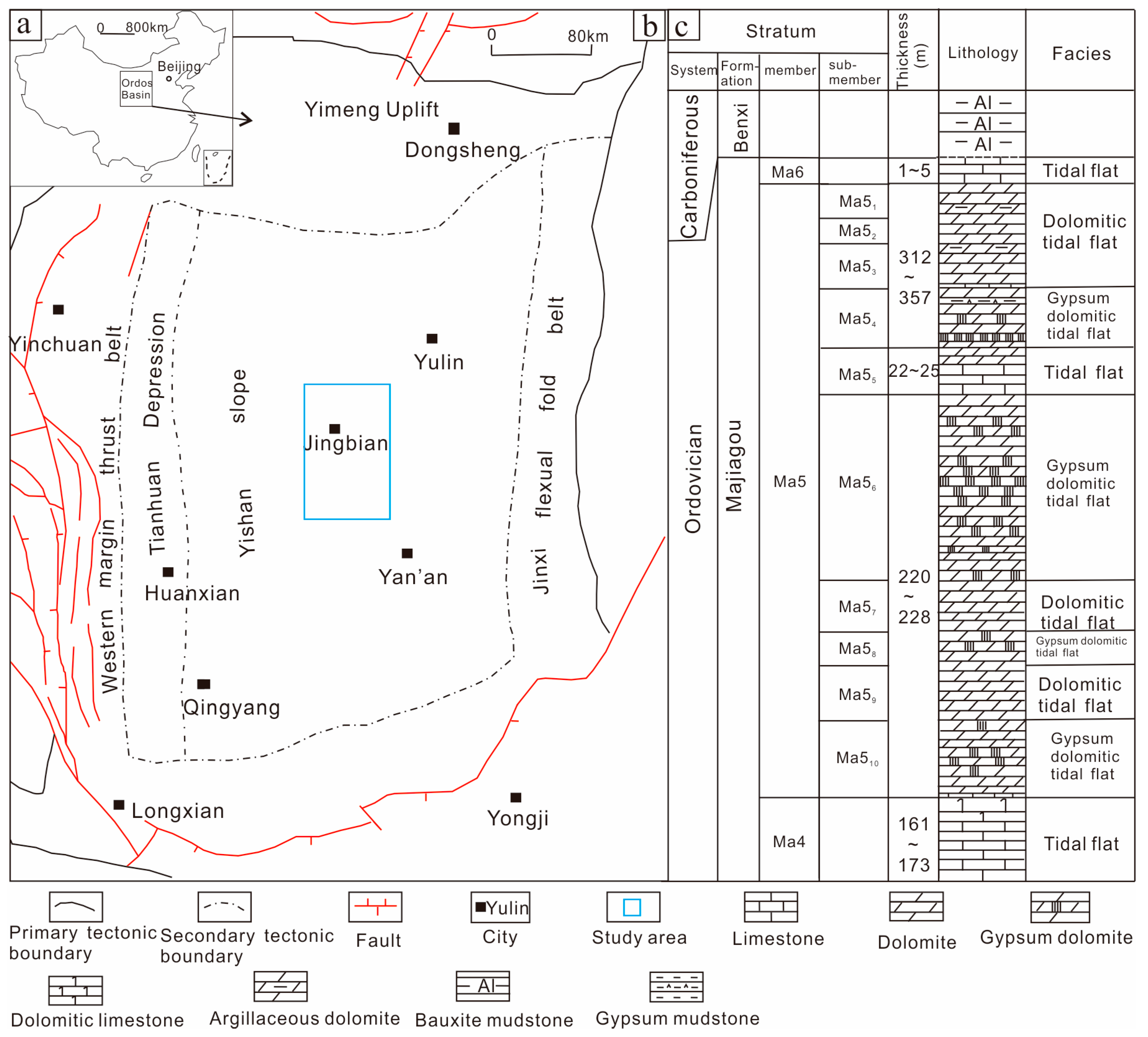
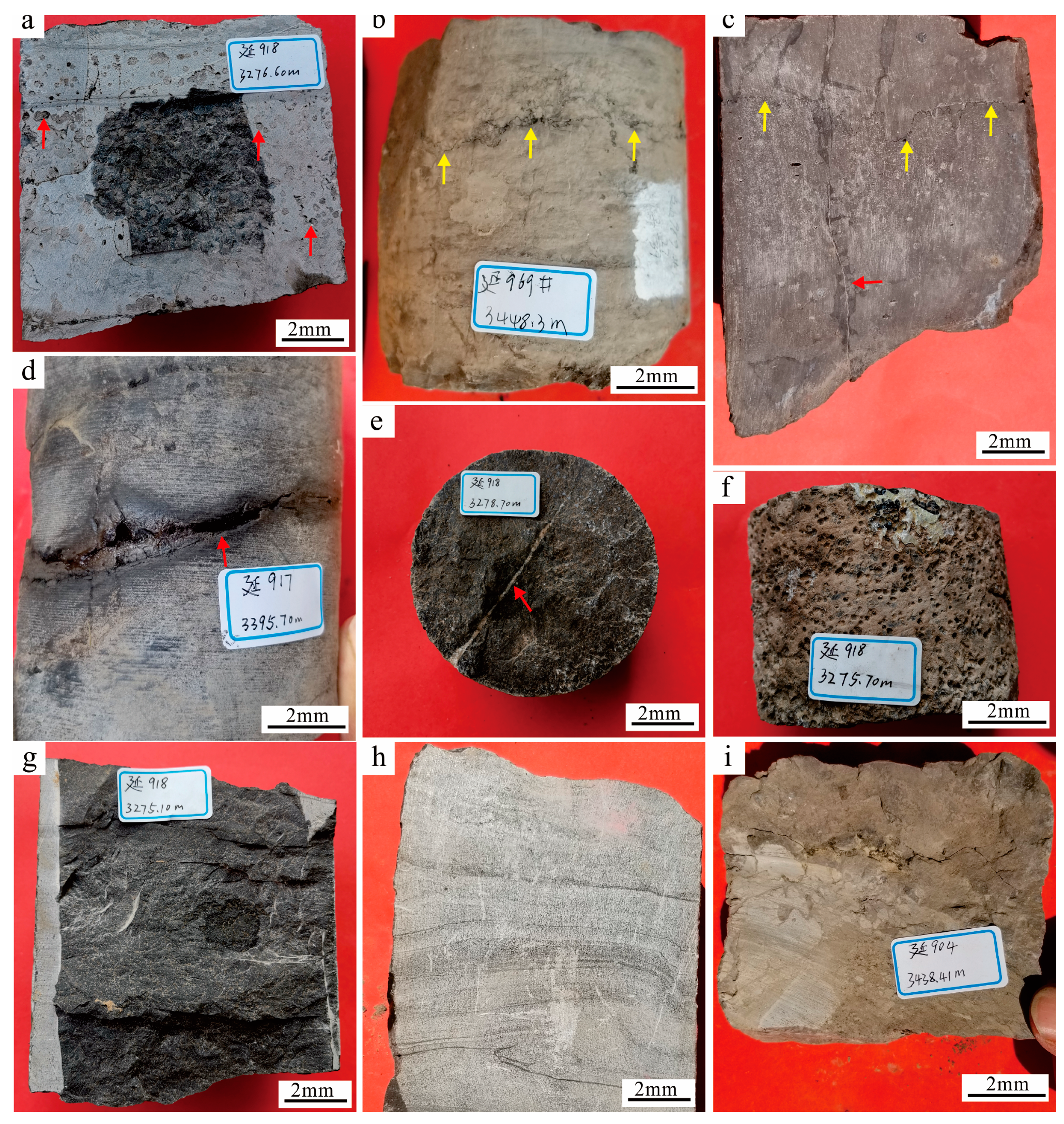
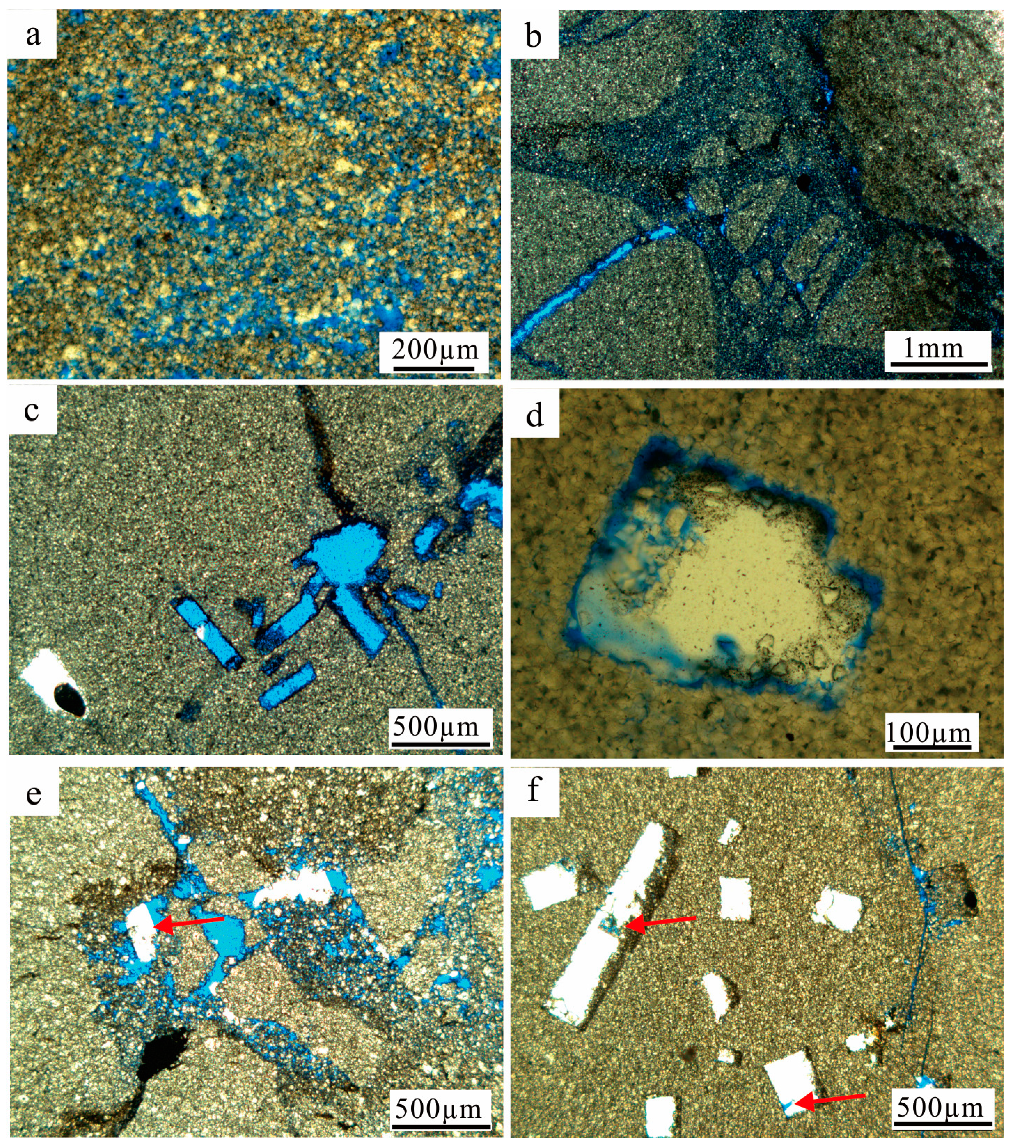
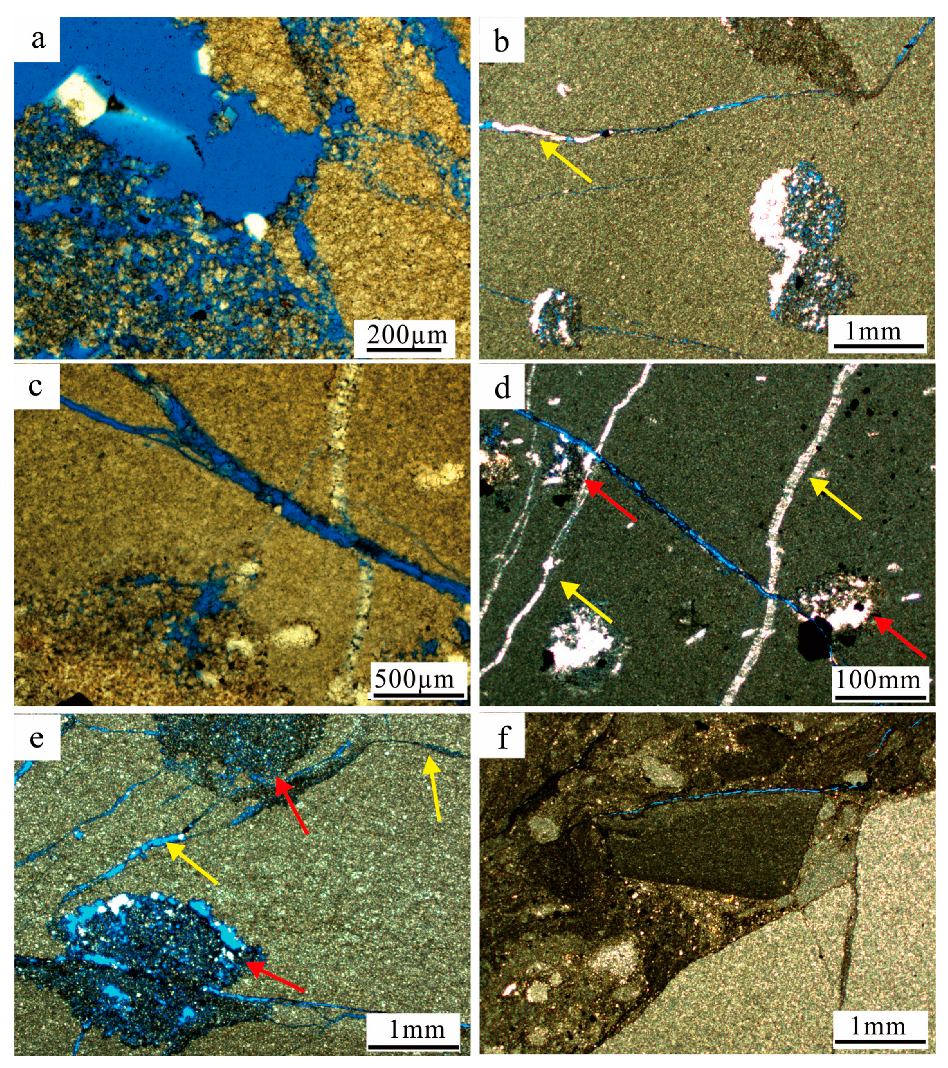


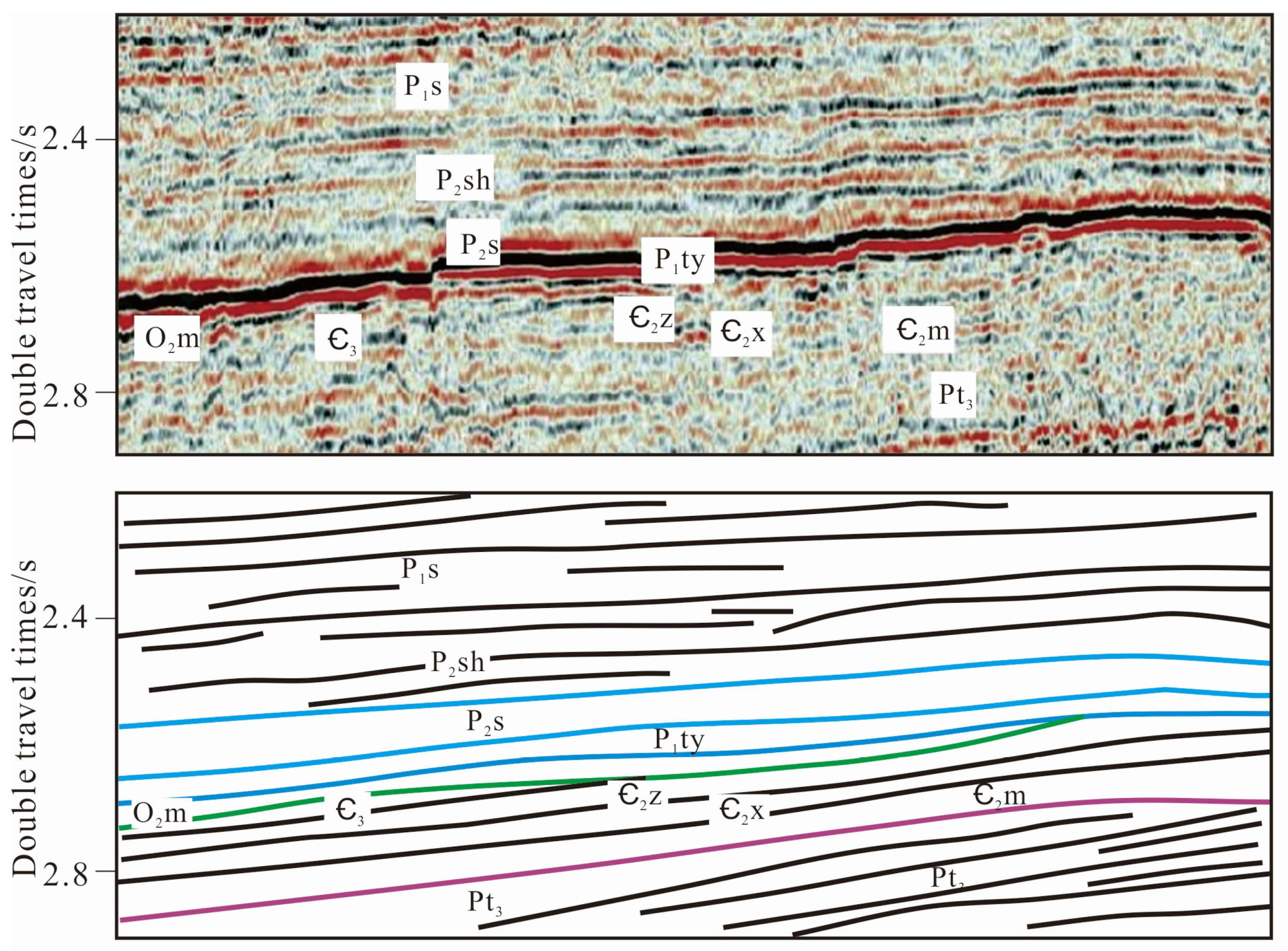
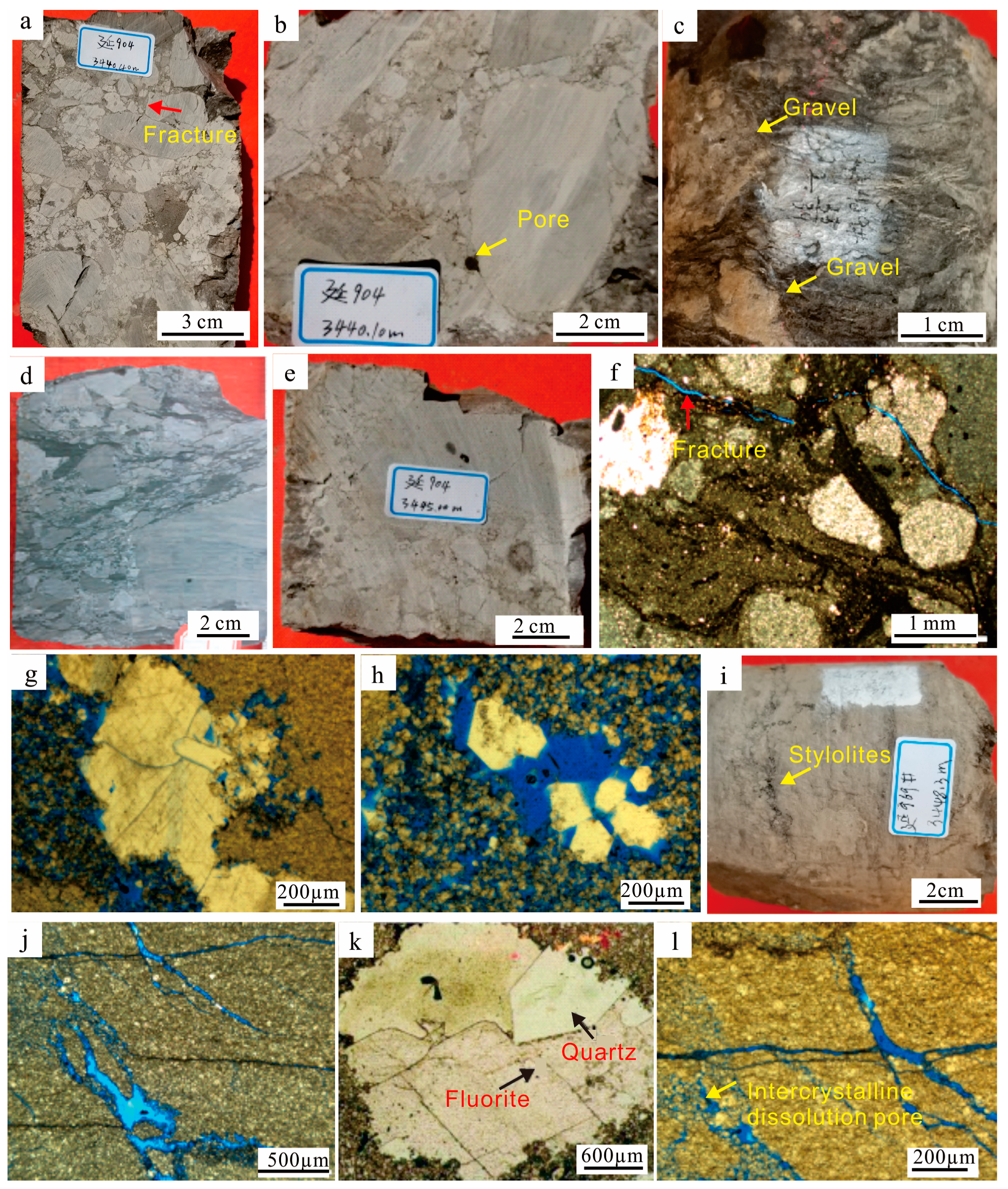
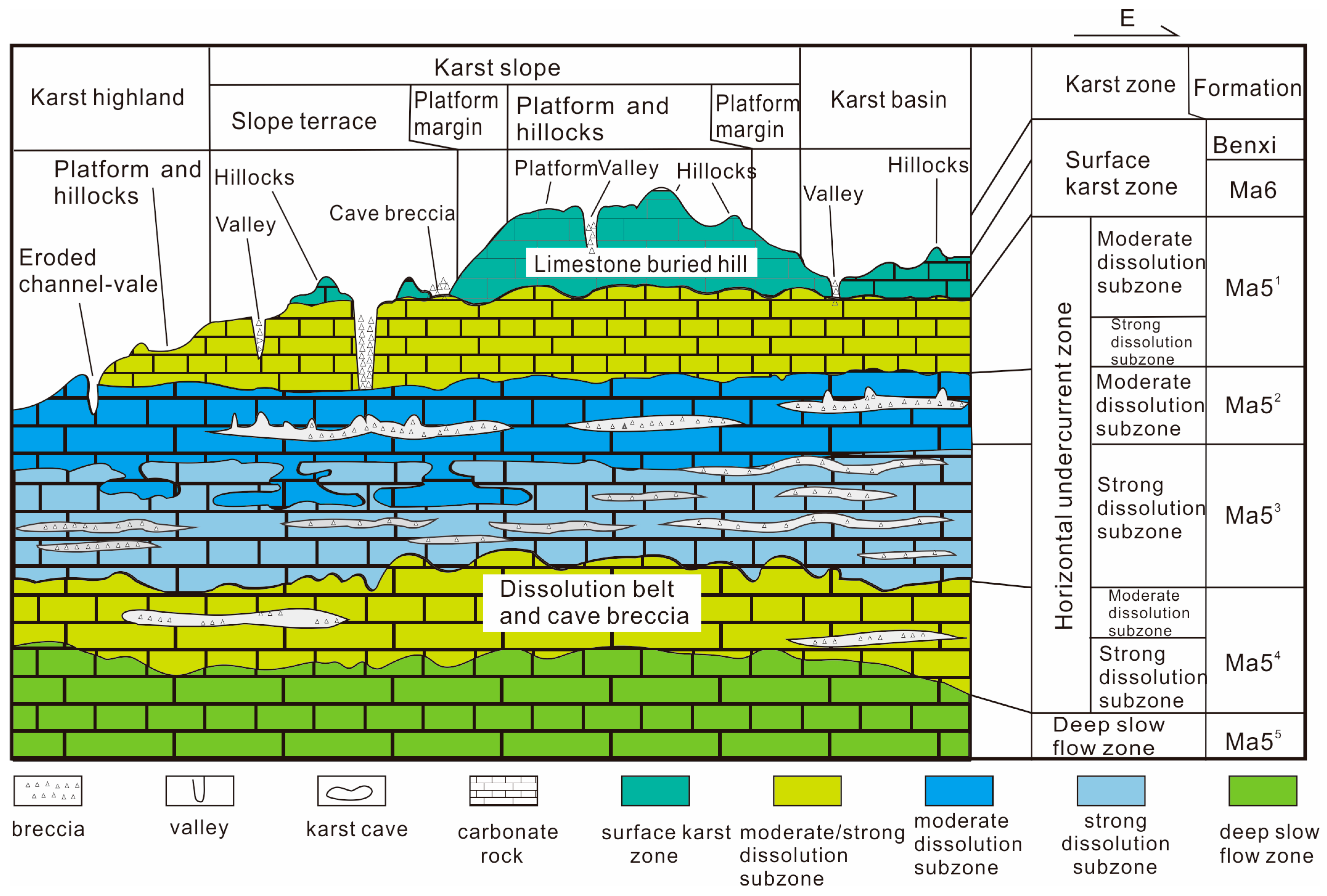

Disclaimer/Publisher’s Note: The statements, opinions and data contained in all publications are solely those of the individual author(s) and contributor(s) and not of MDPI and/or the editor(s). MDPI and/or the editor(s) disclaim responsibility for any injury to people or property resulting from any ideas, methods, instructions or products referred to in the content. |
© 2023 by the authors. Licensee MDPI, Basel, Switzerland. This article is an open access article distributed under the terms and conditions of the Creative Commons Attribution (CC BY) license (https://creativecommons.org/licenses/by/4.0/).
Share and Cite
Peng, X.; Li, G.; Cheng, X.; Guo, L. Karstification and Its Role in the Formation of Carbonate Reservoirs: A Case Study from the Ordovician Majiagou Formation in Jingbian, Ordos Basin, North China. Minerals 2023, 13, 1425. https://doi.org/10.3390/min13111425
Peng X, Li G, Cheng X, Guo L. Karstification and Its Role in the Formation of Carbonate Reservoirs: A Case Study from the Ordovician Majiagou Formation in Jingbian, Ordos Basin, North China. Minerals. 2023; 13(11):1425. https://doi.org/10.3390/min13111425
Chicago/Turabian StylePeng, Xiaoxia, Guobin Li, Xin Cheng, and Ling Guo. 2023. "Karstification and Its Role in the Formation of Carbonate Reservoirs: A Case Study from the Ordovician Majiagou Formation in Jingbian, Ordos Basin, North China" Minerals 13, no. 11: 1425. https://doi.org/10.3390/min13111425
APA StylePeng, X., Li, G., Cheng, X., & Guo, L. (2023). Karstification and Its Role in the Formation of Carbonate Reservoirs: A Case Study from the Ordovician Majiagou Formation in Jingbian, Ordos Basin, North China. Minerals, 13(11), 1425. https://doi.org/10.3390/min13111425




